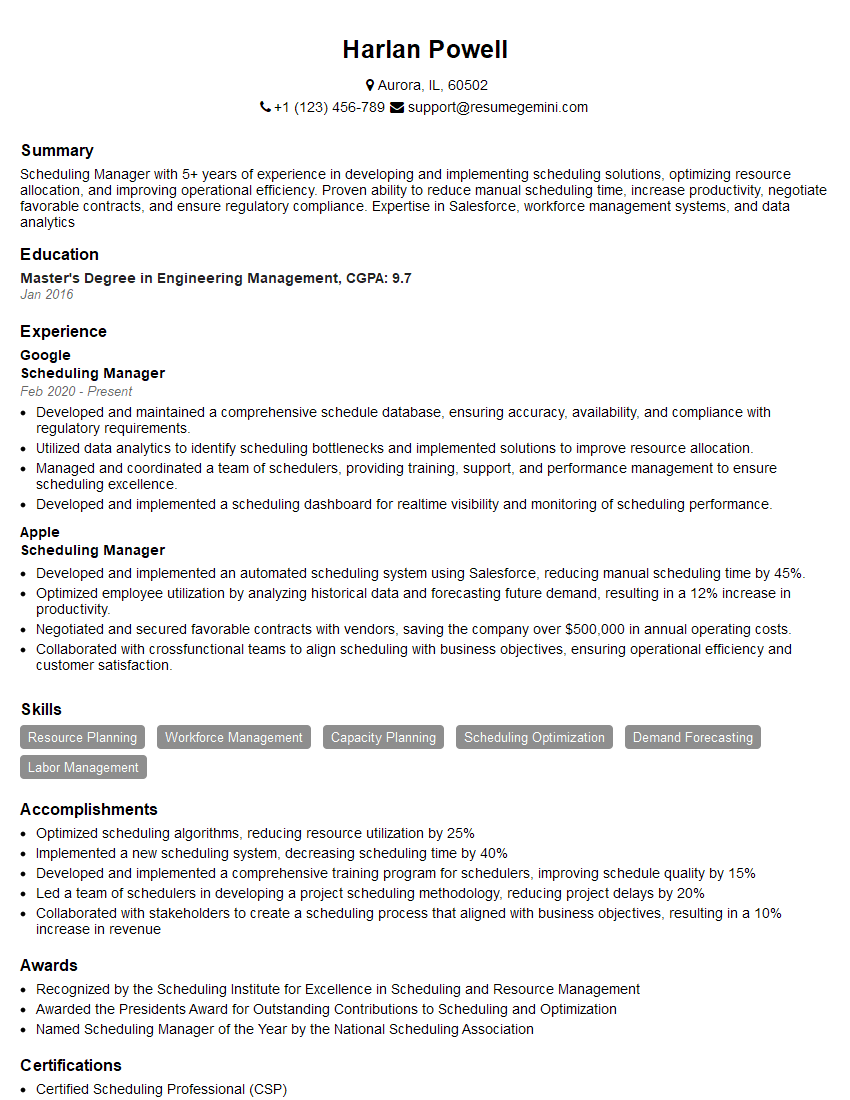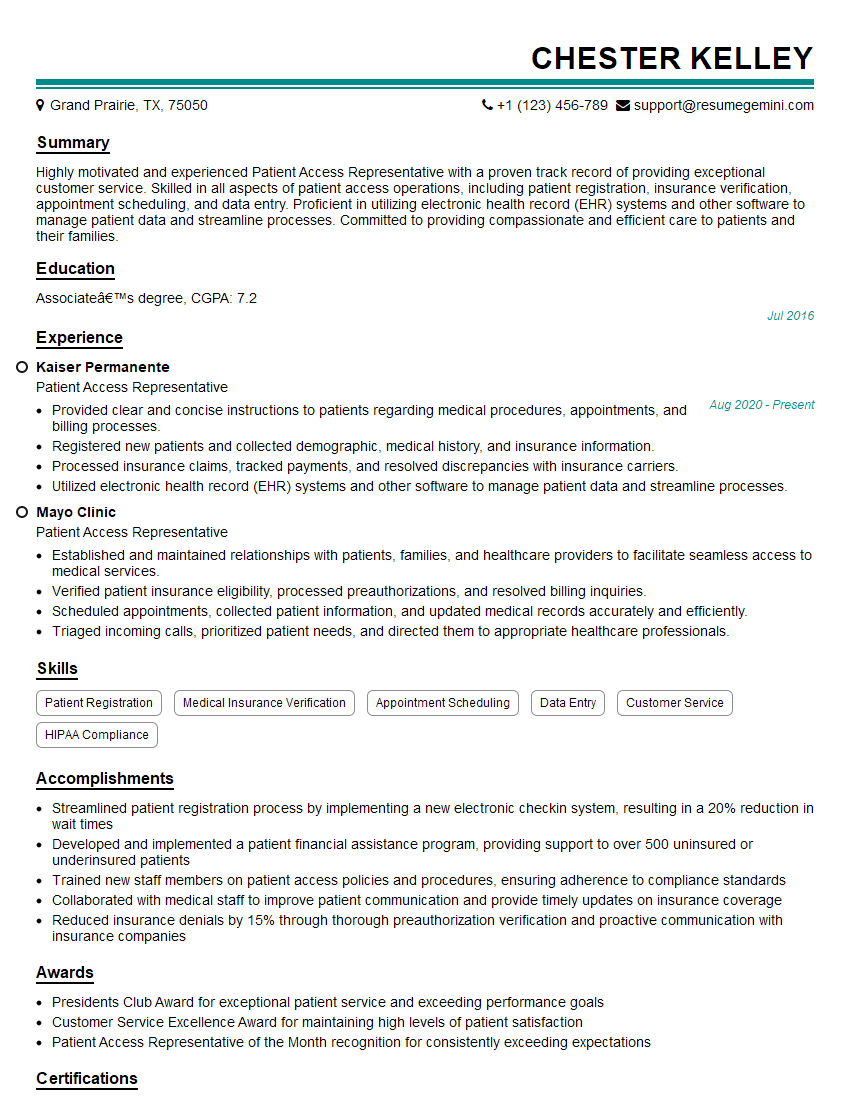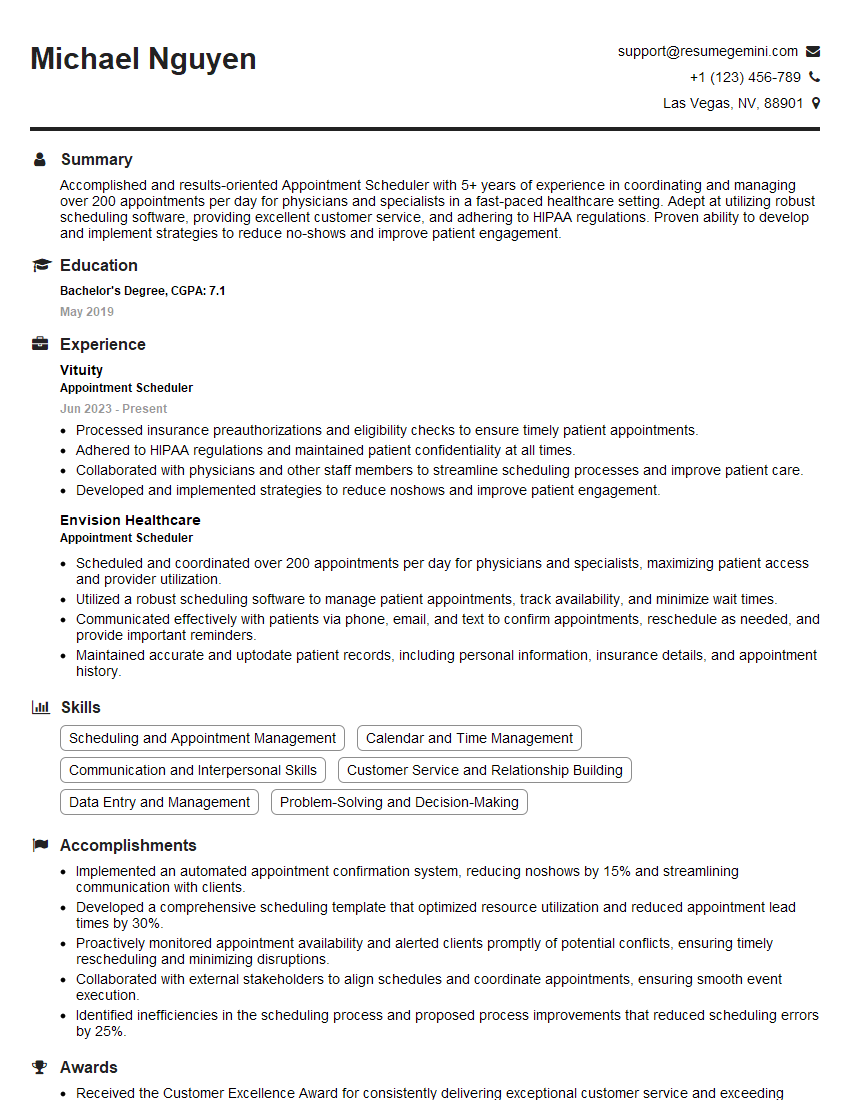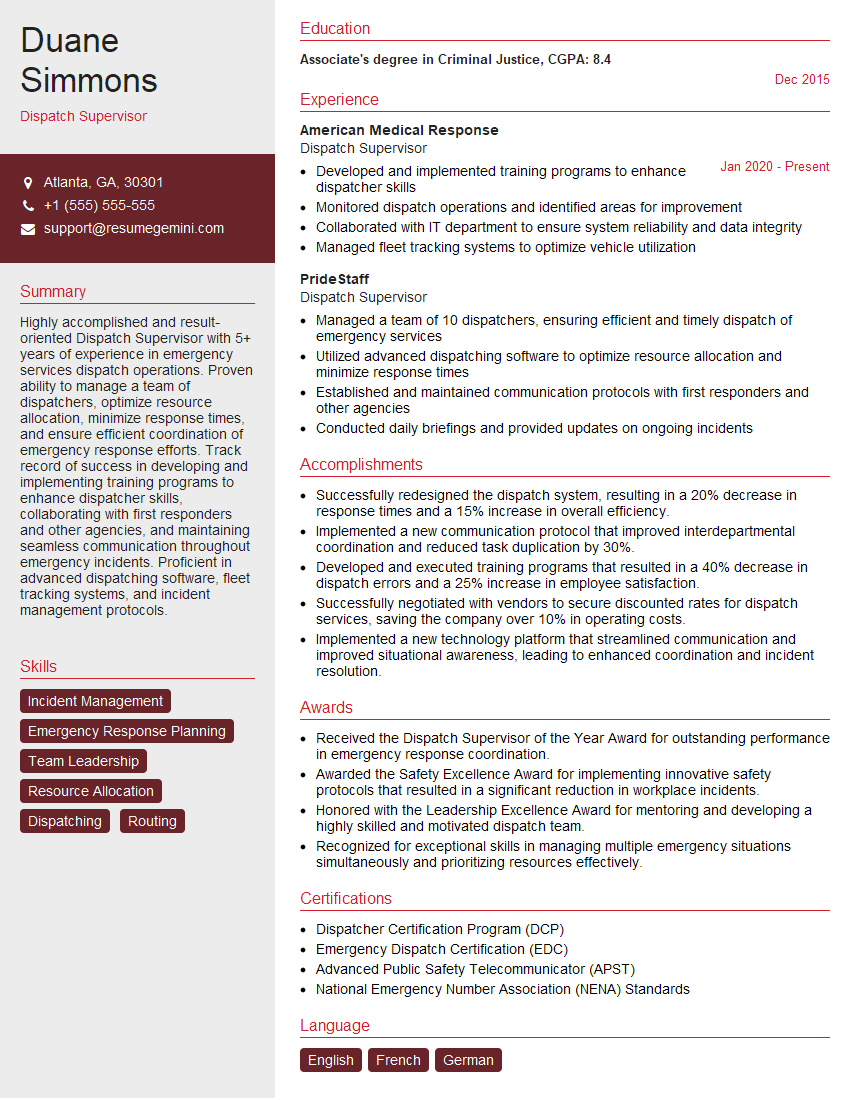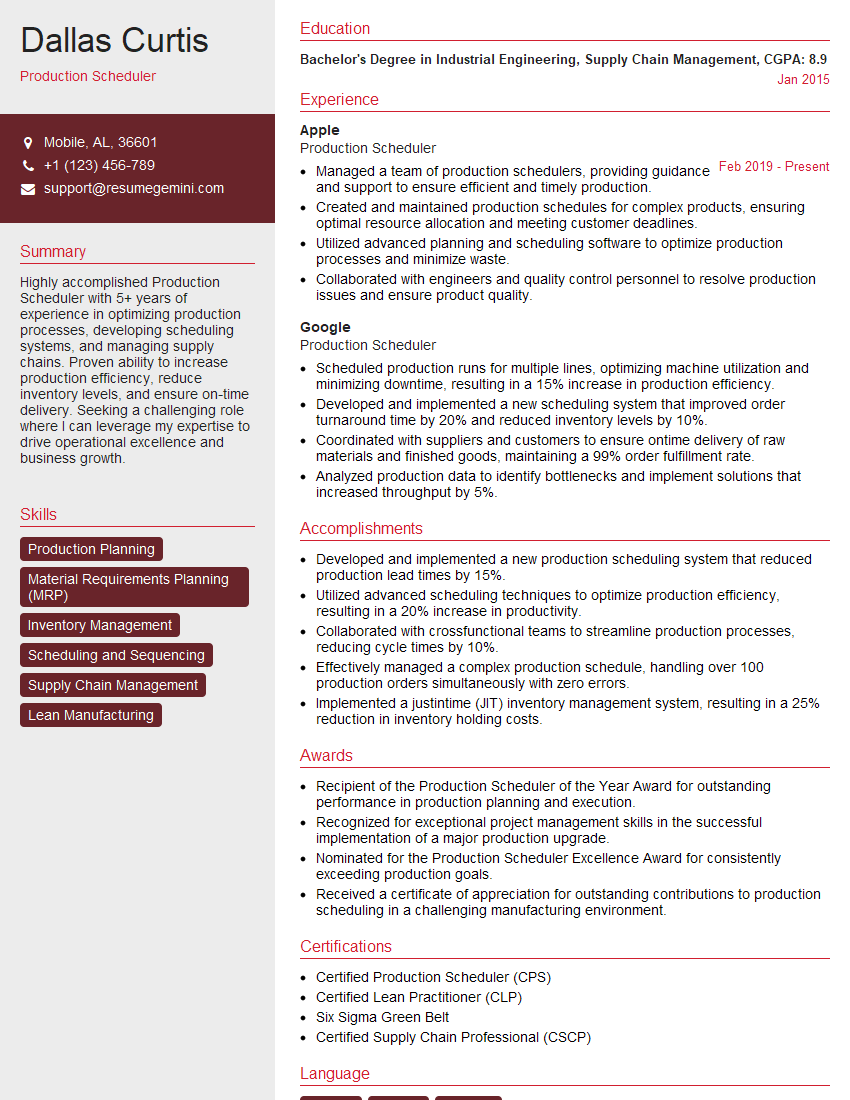Every successful interview starts with knowing what to expect. In this blog, we’ll take you through the top Scheduling and Triage interview questions, breaking them down with expert tips to help you deliver impactful answers. Step into your next interview fully prepared and ready to succeed.
Questions Asked in Scheduling and Triage Interview
Q 1. Describe your experience with different scheduling methodologies (e.g., Kanban, Agile, Waterfall).
My experience encompasses a range of scheduling methodologies, each suited to different project types and team dynamics.
- Waterfall: This is a linear, sequential approach. I’ve used it successfully for projects with clearly defined requirements and minimal anticipated changes. Think building a house – you wouldn’t start painting before the foundation is laid. The advantage is its simplicity and predictability, but it struggles with adaptability to evolving needs.
- Agile (Scrum, Kanban): Agile methodologies, particularly Scrum and Kanban, are iterative and emphasize flexibility. I’ve extensively utilized Scrum in software development projects, breaking down work into sprints with daily stand-ups for progress tracking and adjustment. Kanban’s visual workflow management is excellent for continuous delivery projects, allowing for easy prioritization and bottleneck identification. For example, in a customer service team, Kanban boards visually represent tasks, their progress, and bottlenecks.
- Kanban: Pure Kanban is highly visual, using boards to track work items as they move through stages. I’ve found it effective for managing ongoing tasks and projects with fluctuating priorities, offering greater flexibility than Waterfall.
My choice of methodology depends heavily on the project’s complexity, the team’s size and experience, and the degree of uncertainty involved. I’m comfortable adapting my approach to optimize efficiency and responsiveness.
Q 2. How do you prioritize tasks in a high-pressure environment with competing deadlines?
Prioritizing in high-pressure situations demands a structured approach. I employ a combination of techniques:
- Impact vs. Urgency Matrix (Eisenhower Matrix): This matrix categorizes tasks based on their urgency and impact. High-impact, urgent tasks take precedence, while low-impact, non-urgent tasks are delegated or deferred. This helps prevent fire-fighting and ensures focus on the most crucial items.
- MoSCoW Method: This prioritization technique categorizes requirements into Must have, Should have, Could have, and Won’t have. This clarifies what’s essential versus desirable, guiding resource allocation accordingly.
- Dependency Analysis: I identify tasks that depend on others, creating a clear sequence for execution. This prevents blocking and ensures smooth workflow.
- Risk Assessment: High-risk tasks often deserve higher priority to minimize potential disruptions.
Furthermore, clear communication with stakeholders is crucial. Transparency on prioritization rationale and potential delays builds trust and facilitates collaboration.
Q 3. Explain your approach to managing multiple simultaneous scheduling requests.
Managing multiple simultaneous scheduling requests involves careful organization and clear communication.
- Centralized Scheduling System: I utilize a shared calendar or scheduling tool (mentioned in a later answer) to gain a holistic view of all requests. This minimizes double-booking and conflicting assignments.
- Prioritization Framework: I apply the prioritization techniques discussed earlier to determine the order in which requests are addressed.
- Resource Allocation: I assess resource availability (people, equipment, etc.) and assign tasks accordingly, optimizing resource utilization.
- Communication Protocol: I maintain open communication with all stakeholders, providing regular updates and managing expectations effectively.
- Buffer Time: I build in buffer time to account for unexpected delays or emergencies.
Think of it like air traffic control – many planes need to land and take off safely and efficiently. A robust system is needed to manage the complexity and prevent collisions.
Q 4. How do you handle conflicting schedules or resource constraints?
Conflicting schedules and resource constraints are inevitable. My approach focuses on proactive resolution:
- Negotiation and Collaboration: I work with stakeholders to find mutually acceptable solutions. This might involve adjusting deadlines, re-allocating resources, or re-prioritizing tasks.
- Constraint Analysis: I identify the root causes of conflicts—is it a lack of resources, unrealistic deadlines, or poor communication?
- Alternative Solutions: I brainstorm and propose alternative scheduling options or workarounds to resolve conflicts.
- Escalation: If conflicts cannot be resolved internally, I escalate the issue to relevant decision-makers.
For example, if two projects require the same specialist at the same time, I might negotiate a revised timeline or seek an interim solution, possibly bringing in external resources. Open communication is key.
Q 5. Describe a time you had to reschedule a critical task due to unforeseen circumstances.
In a previous project, a critical software release was scheduled for a specific date. However, unforeseen issues emerged during the final testing phase – a crucial bug emerged which required a considerable amount of time for debugging.
My immediate response was to convene an emergency meeting with the development team, QA, and project stakeholders. We assessed the impact and the time needed to fix the bug. We then communicated this delay transparently to all stakeholders, offering revised timelines and mitigating actions to minimize the impact. This involved prioritizing the bug fix above all else, working extended hours, and effectively communicating the updated plan. Ultimately, the release was delayed by a week, but the quality of the product remained high and further problems were prevented.
Q 6. What software or tools are you proficient in for scheduling and resource management?
I’m proficient in several scheduling and resource management tools, including:
- Microsoft Project: For detailed project planning, tracking, and resource allocation.
- Jira: For Agile project management, bug tracking, and task assignment.
- Asana/Trello: For task management and visual workflow representation. I’m comfortable with Kanban-style boards in these tools.
- Google Calendar/Outlook Calendar: For scheduling meetings and appointments, along with integration into other project management tools for holistic views.
My expertise extends beyond simple scheduling; I understand how to leverage these tools to gain actionable insights into project progress, potential risks, and resource utilization. This allows for proactive intervention and course correction where needed.
Q 7. How do you ensure accuracy and efficiency in your scheduling processes?
Accuracy and efficiency are paramount. I achieve this through:
- Double-Checking: Thorough verification of all scheduled tasks and resource allocations minimizes errors.
- Standardization: Implementing consistent scheduling processes and using templates streamlines workflow and reduces variability.
- Regular Monitoring: Continuous tracking of progress and resource utilization allows for early identification of potential issues.
- Data-Driven Decisions: Utilizing project management software to gather data provides insights for better planning and resource allocation in future projects.
- Continuous Improvement: Regular reviews of the scheduling process identify areas for enhancement. I actively seek feedback to identify bottlenecks and optimize efficiency.
In essence, my approach is proactive, data-driven, and focused on continuous improvement to ensure both accurate scheduling and optimal resource utilization. This is essential for consistent project success.
Q 8. How familiar are you with capacity planning and forecasting?
Capacity planning and forecasting are crucial for effective scheduling and resource allocation. Capacity planning involves determining the resources (staff, tools, infrastructure) needed to meet projected demands, while forecasting predicts future workload based on historical data, trends, and anticipated changes. Think of it like planning a large party: you need to forecast how many guests will attend to plan the food, seating, and entertainment (forecasting), then you determine how many servers, bartenders, and decorations you’ll need to handle that number (capacity planning).
My approach involves using a combination of quantitative and qualitative methods. Quantitative methods include analyzing historical data on ticket resolution times, incident volume, and resource utilization. I use statistical models and forecasting techniques like exponential smoothing or ARIMA to project future demand. Qualitative methods involve considering upcoming projects, seasonal variations, and potential disruptions (e.g., planned maintenance). This holistic view helps refine the forecasts and improve the accuracy of capacity planning.
For instance, I once worked on a project where analyzing past incident data revealed a surge in tickets during the holiday season. Using this information, we proactively increased staffing levels and scheduled additional training sessions to handle the expected increase in workload, preventing a significant backlog and ensuring service level agreements were met.
Q 9. How do you assess the urgency and importance of incoming requests or incidents in a triage setting?
Triage in a scheduling context prioritizes requests based on urgency and impact. I use a prioritization matrix, often a simple 2×2 grid, where one axis represents urgency (how quickly it needs addressing) and the other represents impact (how severe the consequences of delay are). This allows for a structured approach to prioritizing incoming requests. For example:
- High Urgency, High Impact: System outages, security breaches – immediate action required.
- High Urgency, Low Impact: Minor application glitches affecting a few users – quick resolution is desirable.
- Low Urgency, High Impact: Planned maintenance, large-scale project implementations – requires careful scheduling but doesn’t need immediate attention.
- Low Urgency, Low Impact: Routine maintenance tasks, feature requests – can be scheduled for later.
I supplement this with clearly defined service level agreements (SLAs), outlining expected resolution times for different priority levels. This provides transparency and ensures alignment between expectations and resources.
Q 10. Explain your process for escalating issues or requests that fall outside your area of expertise.
Escalating issues is a key part of effective triage. My process involves clearly documenting the issue, including all relevant details (error messages, logs, user descriptions) and then forwarding it to the appropriate team or individual. I use a well-defined escalation path, typically outlined in a runbook or documented procedure, detailing who is responsible for each type of issue. This might involve routing network issues to the network team, database problems to the database administrators, or application bugs to the development team.
Effective communication during escalation is crucial. I use a clear and concise communication template which includes the problem statement, relevant context, priority level, and steps already taken. I also ensure to follow up to verify receipt and track progress. Using a ticketing system with robust notification capabilities streamlines this process and provides a central repository for tracking progress.
Q 11. Describe your experience with different triage systems or methodologies.
I’ve worked with several triage systems, including:
- Prioritization matrices: As described previously, these offer a structured way to assess urgency and impact.
- Ticketing systems (e.g., Jira, ServiceNow): These systems provide a centralized location for managing requests, assigning priorities, and tracking progress. They often incorporate workflow automation and reporting capabilities.
- Kanban boards: Visual task management tools, particularly useful for visualizing workflow and identifying bottlenecks. These help in managing a large number of tasks concurrently.
Each system has its strengths and weaknesses. The choice depends on the organization’s size, complexity, and specific needs. For instance, a small team might benefit from a simple prioritization matrix and a shared spreadsheet, whereas a large enterprise would benefit from a sophisticated ticketing system with advanced features.
Q 12. How do you handle a high volume of incoming requests or incidents simultaneously?
Handling a high volume of requests requires a structured and efficient approach. This typically involves:
- Prioritization: Employing the triage methods already discussed, focusing on high-impact issues first.
- Batching: Grouping similar requests together to streamline processing.
- Automation: Automating routine tasks wherever possible (e.g., automated responses to common inquiries).
- Teamwork: Working collaboratively with colleagues, distributing workload effectively.
- Effective communication: Keeping stakeholders informed about delays or changes in priority.
Think of it like a hospital emergency room: the most critical cases are addressed first, similar cases might be treated in groups, routine check-ups are scheduled, and a team of doctors and nurses works together to manage the flow of patients. Using tools like Kanban boards provides visibility and helps the team efficiently manage the workload.
Q 13. How do you maintain clear and concise communication during a triage situation?
Clear and concise communication is paramount during triage. I use the following strategies:
- Structured communication templates: Using standardized templates for incident reports, updates, and escalations ensures consistency and avoids ambiguity.
- Active listening: Carefully listening to the reporter to fully understand the issue and its impact.
- Concise summaries: Providing clear, concise summaries of the problem and the proposed solution.
- Regular updates: Keeping stakeholders informed about progress, potential delays, and changes in plans.
- Appropriate communication channels: Choosing the appropriate communication channel (email, phone, instant messaging) depending on the urgency and nature of the communication.
I always strive to be empathetic and responsive to the needs of the people affected by the incident or request.
Q 14. How do you document and track the progress of scheduled tasks and resolved incidents?
Documentation and tracking are critical for accountability and continuous improvement. I use a combination of tools and processes to achieve this:
- Ticketing systems: These provide a central repository for all requests, incidents, and their resolution status. They allow for detailed tracking of progress, including time spent, assigned personnel, and associated documentation.
- Status reports: Regularly generating reports summarizing the status of scheduled tasks and resolved incidents helps track progress against targets.
- Knowledge base: Documenting common issues and their resolutions in a knowledge base minimizes repetition and improves efficiency.
- Post-incident reviews (PIRs): Conducting PIRs after major incidents to identify areas for improvement in processes and resource allocation.
The key is to maintain a comprehensive and easily accessible record of all activity, allowing for effective monitoring and analysis. This information is invaluable for capacity planning, resource allocation, and continuous service improvement.
Q 15. Describe a time you had to make a difficult decision regarding prioritization in a triage situation.
Prioritization in triage is about making the best use of limited resources to maximize positive outcomes. One particularly difficult situation involved a simultaneous influx of patients – a car accident with multiple injuries, a heart attack, and a severe allergic reaction. Each case demanded immediate attention, but their needs differed drastically in urgency and resource requirements. My decision-making process involved a rapid assessment using a modified version of the START triage system (Simple Triage And Rapid Treatment). This system categorizes patients based on their respiration, perfusion (circulation), and mental status. I quickly identified the heart attack patient as the highest priority due to the immediate risk of cardiac arrest, requiring immediate access to an EKG and the cath lab. Next, I addressed the allergic reaction, administering epinephrine and establishing an airway before the reaction became irreversible. Finally, I delegated care for the car accident victims, prioritizing those with the most life-threatening injuries based on their START triage score. This involved clear communication with the paramedics and nurses to ensure efficient allocation of staff and equipment. While this was stressful, the systematic approach prevented misallocation of resources and ensured that every patient received the care they needed in a timely manner.
Career Expert Tips:
- Ace those interviews! Prepare effectively by reviewing the Top 50 Most Common Interview Questions on ResumeGemini.
- Navigate your job search with confidence! Explore a wide range of Career Tips on ResumeGemini. Learn about common challenges and recommendations to overcome them.
- Craft the perfect resume! Master the Art of Resume Writing with ResumeGemini’s guide. Showcase your unique qualifications and achievements effectively.
- Don’t miss out on holiday savings! Build your dream resume with ResumeGemini’s ATS optimized templates.
Q 16. How do you ensure that all relevant information is gathered and communicated during triage?
Gathering and communicating relevant information during triage is crucial for effective decision-making. I employ a structured approach that involves several key steps. First, I perform a rapid initial assessment, focusing on the patient’s chief complaint and vital signs. This initial assessment informs the next steps. Then, I use open-ended questions to gather a complete medical history relevant to the presenting complaint. For example, instead of asking “Do you have allergies?”, I ask, “Tell me about any allergies you may have, including reactions.” This approach elicits more complete and informative responses. Simultaneously, I document all findings using standardized forms, including allergies, medications, and past medical history, ensuring complete records for continuity of care. To effectively communicate this information, I use a combination of verbal hand-offs to the appropriate care team members (nurses, doctors, technicians) and a clear, concise summary in the patient’s electronic health record (EHR). This ensures all stakeholders have access to the critical information needed to provide the best possible care.
Q 17. What are some common challenges in scheduling and triage, and how have you overcome them?
Common challenges in scheduling and triage include unexpected surges in patient volume, staff shortages, equipment malfunction, and conflicting priorities. For example, a sudden weather event can lead to a dramatic increase in trauma patients requiring immediate care, straining resources. To overcome these challenges, I utilize flexible scheduling models that accommodate fluctuating demands, including cross-training staff to handle multiple roles and preparing surge plans for unexpected events. I prioritize tasks based on urgency and impact and regularly review resource utilization to identify bottlenecks. For example, if we frequently face delays in radiology, we’d analyze workflow, consider additional staffing or equipment, and potentially explore alternative imaging methods. Transparent communication is key – informing staff and patients about potential delays helps manage expectations and maintains morale.
Q 18. How do you handle difficult or demanding individuals during the scheduling or triage process?
Handling difficult or demanding individuals requires empathy, active listening, and clear communication. I start by acknowledging their concerns and validating their feelings. For instance, if a patient is upset about a long wait time, I’d say something like, “I understand your frustration with the wait. Let me see what I can do to help.” Then, I calmly explain the situation, providing factual information and a realistic timeline. I avoid getting defensive or engaging in arguments. If a patient continues to be abusive, I involve a supervisor or security as appropriate to ensure the safety of staff and other patients. The goal is de-escalation and providing the best possible care, while also maintaining a safe and respectful environment for all.
Q 19. How do you measure the effectiveness of your scheduling and triage processes?
Measuring the effectiveness of scheduling and triage involves several key metrics. We track patient wait times, from arrival to initial assessment and subsequent treatment, aiming for benchmarks that align with industry standards and patient satisfaction goals. We monitor the rate of patient cancellations and no-shows to refine scheduling processes. We assess the accuracy of triage assignments by analyzing the concordance between the initial assessment and the patient’s final diagnosis to identify areas for improvement in our assessment skills. We track patient satisfaction through surveys and feedback mechanisms, gauging their experience with the triage and scheduling processes. These metrics are reviewed regularly, and data analysis informs the development of strategies to optimize processes and enhance patient care.
Q 20. What are your strategies for preventing scheduling conflicts or bottlenecks?
Preventing scheduling conflicts and bottlenecks requires a proactive approach. This begins with a robust scheduling system that considers all relevant factors, including staff availability, equipment utilization, and appointment durations. We employ appointment templates to ensure that allocated time appropriately reflects the complexity of various procedures. We also implement appointment reminders to reduce no-shows and optimize resource allocation. Regular review of the schedule identifies potential conflicts and allows for proactive adjustments. We strive for efficient workflow design, minimizing unnecessary delays and hand-offs between departments. For example, pre-admission testing and information gathering can reduce delays during actual appointments. Finally, we use real-time monitoring tools to quickly identify and address emerging bottlenecks, allowing us to adapt to unexpected challenges and ensure smooth operation.
Q 21. Describe your experience with reporting and data analysis related to scheduling and triage.
My experience with reporting and data analysis in scheduling and triage is extensive. I’m proficient in using various data analysis tools to extract and interpret data from EHR systems and scheduling software. I regularly generate reports on key performance indicators (KPIs) such as average wait times, patient throughput, resource utilization, and staff productivity. These reports are used to identify trends, assess the effectiveness of implemented changes, and support evidence-based decision-making. I use data visualization techniques such as charts and graphs to communicate findings effectively to stakeholders, including management and staff. For example, I might use a control chart to monitor wait times over time, identifying periods of significant variation and allowing us to investigate the root cause. This data-driven approach is crucial for continuous improvement in the scheduling and triage processes and ensures optimal patient care.
Q 22. How do you use technology to improve the efficiency of your scheduling and triage work?
Technology plays a crucial role in optimizing scheduling and triage. I leverage several tools to enhance efficiency. For instance, I use sophisticated scheduling software that incorporates algorithms to optimize resource allocation, minimizing wait times and maximizing utilization. This software often includes features like automated appointment reminders, online booking capabilities, and real-time availability updates. Further, I utilize patient management systems (PMS) that integrate with the scheduling software for seamless data flow, reducing manual data entry and minimizing errors. For triage, I often use electronic health record (EHR) systems with integrated clinical decision support tools. These tools can help prioritize patients based on acuity level, providing structured guidance for rapid assessment and appropriate care allocation. Finally, communication tools like secure messaging platforms and telehealth integration streamline communication with patients and other healthcare providers, reducing delays and improving responsiveness.
For example, in a previous role, we implemented a new scheduling system that reduced patient wait times by 15% and increased provider utilization by 10% within the first quarter. The system’s automated reminders also reduced no-show appointments by 8%, a significant improvement in efficiency and resource allocation.
Q 23. Explain your understanding of the impact of effective scheduling and triage on overall organizational efficiency.
Effective scheduling and triage are cornerstones of organizational efficiency. Think of it like a well-oiled machine; every part needs to work seamlessly. Poor scheduling leads to wasted time, frustrated staff, and unhappy patients. Conversely, a robust scheduling system ensures that resources—staff, equipment, and time—are used optimally. Likewise, effective triage ensures that patients receive the appropriate level of care in a timely manner. This prevents minor issues from escalating and allows for the efficient allocation of resources to those who need it most. For instance, rapid triage can prevent severe complications, ensuring patient safety and potentially reducing the need for more extensive (and expensive) interventions later on. Reduced wait times lead to increased patient satisfaction and a better overall reputation for the organization. Ultimately, improvements in these areas translate to cost savings, improved productivity, and better patient outcomes—all vital components of organizational success.
Q 24. How do you stay organized and manage your workload effectively in a fast-paced environment?
Managing a fast-paced environment requires a structured approach. I rely heavily on prioritization techniques like the Eisenhower Matrix (urgent/important) to categorize tasks. This helps me focus on critical items first, while delegating or scheduling less urgent tasks. I also use digital tools like project management software (Asana, Trello) and calendar applications (Google Calendar, Outlook) to track deadlines, appointments, and progress. These tools allow for task assignment, collaboration, and real-time updates. I break down large tasks into smaller, manageable steps to avoid feeling overwhelmed. Regular time blocking helps allocate dedicated time slots for specific activities, enhancing focus and minimizing distractions. Furthermore, I prioritize breaks to maintain focus and prevent burnout. The key is to find a balance between proactive planning and responsive adaptation to unexpected events, which is a skill honed over time through experience and consistent refinement.
For instance, I might allocate the first two hours of my day to reviewing urgent patient requests, followed by a dedicated block for administrative tasks, and then time for proactive scheduling or strategic planning.
Q 25. Describe your approach to continuous improvement in your scheduling and triage skills.
Continuous improvement is vital in this field. I actively seek opportunities for professional development through workshops, online courses, and industry conferences. I stay updated on the latest technological advancements and best practices in scheduling and triage. Regularly reviewing my processes and identifying areas for optimization is a cornerstone of my approach. Data analysis is key—tracking key performance indicators (KPIs) allows me to identify bottlenecks, assess the effectiveness of changes, and justify the need for further improvements. I also value feedback from colleagues and patients. Constructive criticism provides valuable insights into areas needing attention. Implementing changes in a controlled manner, monitoring their effects, and making adjustments as necessary, is crucial. The goal is not just to improve efficiency, but also to enhance the patient experience and ensure the highest quality of care.
Q 26. How do you adapt your approach to scheduling and triage based on different contexts or situations?
Adaptability is crucial. My approach varies significantly depending on the context. For instance, in an emergency room, triage prioritizes patients based on the severity of their condition using a system like the ESI (Emergency Severity Index). The focus is rapid assessment, stabilization, and prioritization of life-threatening cases. In a primary care setting, scheduling might be more appointment-based, focused on preventative care and managing chronic conditions. Here, optimizing appointment lengths and managing patient flow are key. In a specialized clinic, the scheduling and triage might focus on efficient use of specialized equipment or personnel, potentially involving pre-procedure screenings or consultations. I adapt my communication style accordingly, using clear and concise language appropriate to the patient’s understanding and the urgency of the situation. The fundamental principle remains consistent: to ensure efficient resource allocation and timely, appropriate care, but the methodology adapts to the specific requirements of each environment.
Q 27. What are some key performance indicators (KPIs) you would use to measure success in scheduling and triage?
Several KPIs are crucial for measuring success. Patient wait times are a direct indicator of efficiency. Appointment adherence rates (no-shows) reflect the effectiveness of scheduling processes. Provider utilization rates show how effectively staff time is being used. Patient satisfaction scores measure the overall experience. Resource utilization (equipment, rooms) reflects overall efficiency. Triage accuracy, measured by the number of patients appropriately triaged based on their condition, is paramount. Turnaround times (for tests, procedures, etc.) are particularly relevant in specific contexts. By monitoring these KPIs and analyzing trends, I can identify areas for improvement and demonstrate the impact of my efforts. For example, a reduction in patient wait times by 10% and a corresponding increase in patient satisfaction scores would be tangible evidence of successful optimization.
Q 28. How do you handle unexpected events or emergencies that impact your schedule or triage workflow?
Unexpected events require a calm and structured response. My approach involves prioritizing the most critical issues first. This often involves reassessing the existing schedule, identifying the impact of the event, and making adjustments as needed. Clear communication with all stakeholders (staff, patients, supervisors) is essential. I leverage available resources and personnel effectively to handle the situation. In some cases, this might involve rescheduling appointments, re-prioritizing tasks, or escalating the issue to senior management. Documentation is crucial, recording the event, the actions taken, and any resulting changes to the schedule or workflow. The focus is to minimize disruption, ensure patient safety, and maintain the overall efficiency of the system as much as possible. For example, a sudden equipment malfunction might require rescheduling certain procedures, but clear communication and efficient reallocation of resources can minimize the overall impact.
Key Topics to Learn for Scheduling and Triage Interview
- Understanding Appointment Scheduling Systems: Explore different scheduling software and methodologies, including their strengths and weaknesses. Consider the impact of various system features on efficiency and patient experience.
- Prioritization and Triage Techniques: Learn how to effectively assess patient needs and prioritize appointments based on urgency and clinical factors. Understand the ethical implications of triage decisions.
- Workflow Optimization: Analyze how to streamline scheduling processes to reduce wait times, improve patient flow, and maximize resource utilization. Consider the impact of appointment types, appointment durations, and provider availability.
- Communication and Interpersonal Skills: Practice communicating clearly and empathetically with patients, providers, and other stakeholders. Develop techniques for handling difficult conversations and managing patient expectations.
- Data Management and Reporting: Understand how to maintain accurate scheduling records, generate reports on key performance indicators (KPIs), and utilize data to improve scheduling efficiency. Learn to analyze data to identify trends and potential areas for improvement.
- Conflict Resolution and Problem-solving: Develop strategies for addressing scheduling conflicts, double-bookings, and other potential disruptions to the workflow. Practice finding solutions that are fair and efficient for all parties involved.
- Regulatory Compliance and HIPAA: Familiarize yourself with relevant regulations and best practices related to patient confidentiality and data security in scheduling and triage contexts.
Next Steps
Mastering scheduling and triage is crucial for career advancement in healthcare and related fields. These skills are highly valued by employers and demonstrate your ability to manage complex workflows, prioritize effectively, and provide excellent patient care. To significantly boost your job prospects, creating a strong, ATS-friendly resume is essential. ResumeGemini is a trusted resource to help you build a professional and impactful resume that showcases your skills and experience effectively. Examples of resumes tailored to Scheduling and Triage roles are available through ResumeGemini to help guide your resume creation.
Explore more articles
Users Rating of Our Blogs
Share Your Experience
We value your feedback! Please rate our content and share your thoughts (optional).
What Readers Say About Our Blog
There are no reviews yet. Be the first one to write one.

